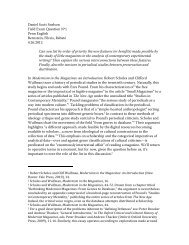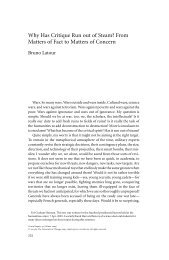The Exploit: A Theory of Networks - asounder
The Exploit: A Theory of Networks - asounder
The Exploit: A Theory of Networks - asounder
Create successful ePaper yourself
Turn your PDF publications into a flip-book with our unique Google optimized e-Paper software.
62 Nodes<br />
Most <strong>of</strong> the networks we are aware <strong>of</strong>—economic, epidemiological,<br />
computational—are dynamic ones. <strong>Networks</strong> exist through “process,”<br />
in Alfred North Whitehead’s sense <strong>of</strong> the term, a “nexus” that involves<br />
a prehension <strong>of</strong> subject, datum, and form.<br />
Perhaps if there is one truism to the study <strong>of</strong> networks, it is that networks<br />
are only networks when they are “live,” when they are enacted, embodied,<br />
or rendered operational.<br />
This applies as much to networks in their potentiality (sleeper<br />
cells, network downtime, idle mobile phones, zombie botnets) as it does<br />
to networks in their actuality. In an everyday sense, this is obvious—<br />
movements <strong>of</strong> exchange, distribution, accumulation, disaggregation,<br />
swarming, and clustering are the very stuff <strong>of</strong> a range <strong>of</strong> environments,<br />
from concentrated cities to transnational economies to cross - cultural<br />
contagions to mobile and wireless technologies. Yet the overwhelming<br />
need to locate, position, and literally pinpoint network nodes <strong>of</strong>ten<br />
obfuscates the dynamic quality <strong>of</strong> the edges. To para phrase Henri Bergson,<br />
we <strong>of</strong>ten tend to understand the dynamic quality <strong>of</strong> networks in<br />
terms <strong>of</strong> stasis; we understand time (or duration) in terms <strong>of</strong> space.<br />
“<strong>The</strong>re are changes, but there are underneath the change no things<br />
which change: change has no need <strong>of</strong> a support. <strong>The</strong>re are movements,<br />
but there is no inert or invariable object which moves: movement<br />
does not imply a mobile.” 31<br />
4. Finally, in an informatic age, networks are <strong>of</strong>ten qualified by their<br />
connectivity, though this is more than a purely technical term.<br />
<strong>The</strong> peculiarly informatic view <strong>of</strong> networks today has brought<br />
with it a range <strong>of</strong> concerns different from other, non - IT - based networks<br />
such as those in transportation or analog communications.<br />
<strong>The</strong> popular discourse <strong>of</strong> cyberspace as a global frontier or as a digital<br />
commons, where access is a commodity, conveys the message that<br />
the political economy <strong>of</strong> networks is managed through connectivity.<br />
As Arquilla and Ronfeldt have commented, whereas an older model<br />
<strong>of</strong> political dissent was geared toward “bringing down the system,”









